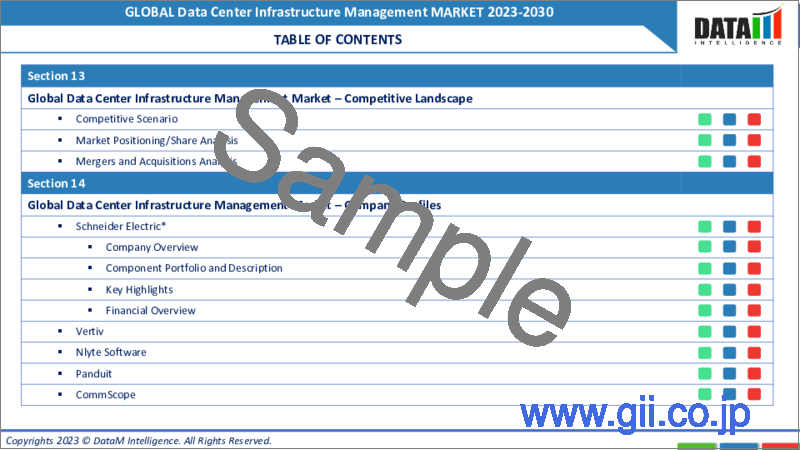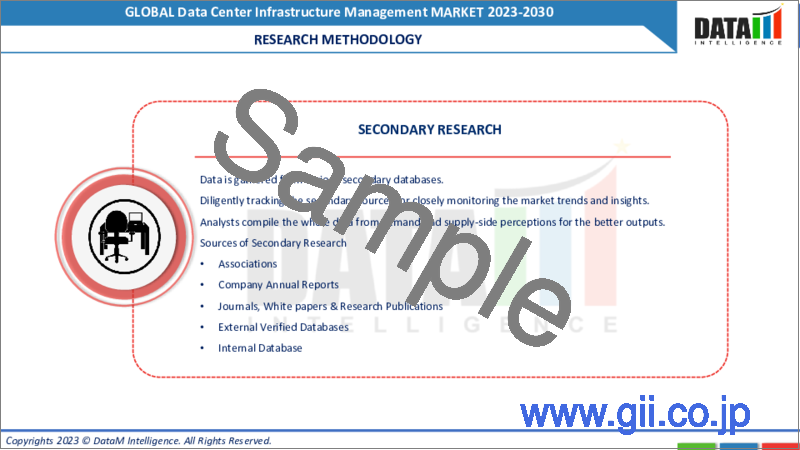|
|
市場調査レポート
商品コード
1285058
データセンターインフラ管理(DCIM)の世界市場-2023-2030Global Data Center Infrastructure Management Market - 2023-2030 |
||||||
カスタマイズ可能
適宜更新あり
|
|||||||
| データセンターインフラ管理(DCIM)の世界市場-2023-2030 |
|
出版日: 2023年06月05日
発行: DataM Intelligence
ページ情報: 英文 245 Pages
納期: 即日から翌営業日
|
- 全表示
- 概要
- 目次
市場概要
データセンターインフラ管理(DCIM)の世界市場規模は、2022年に20億160万米ドルに達し、2030年には最大41億5,410万米ドルに達するなど、有利な成長が予測されています。同市場は、予測期間2023-2030年に13.8%のCAGRで成長する見通しです。
DCIMソリューションは、データセンターのインフラをリアルタイムで監視・分析することで、企業は潜在的な問題を事前に特定し、ダウンタイムやその他の混乱を回避するための予防措置を講じることができます。また、DCIMソフトウェアは、企業がエネルギー使用量を最適化し、コストを削減し、環境の持続可能性を向上させるのに役立つことができます。欧州では、ドイツが欧州地域の市場シェアの25%を占めるリーディングプレーヤーであり、同地域で最も高いCAGRで成長すると予想されています。
市場力学
効率的なデータセンター管理へのニーズの高まり
DCIMソリューションは、データセンターの信頼性と稼働率を向上させることにも貢献します。電源や冷却システムなどの重要なインフラコンポーネントをリアルタイムで監視・分析することで、DCIMソフトウェアは、組織が潜在的な問題を事前に特定し、ダウンタイムを回避するための予防措置を講じることを支援することができます。
また、クラウドサービスに対する需要の高まりやエネルギーコストの上昇により、効率的なデータセンター管理の必要性はますます高まっています。DCIMソリューションは、企業がデータセンターのエネルギー使用量を管理し、無駄な領域を特定し、エネルギー消費を最適化することで、エネルギーコストの削減と環境の持続可能性の向上を実現することができます。
したがって、効率的なデータセンター管理の必要性がDCIMソリューションの導入を促進しており、データセンター運用の最適化とコスト削減を目指す組織にとって不可欠なツールになりつつあります。
導入の複雑さ
DCIMソリューションは、導入が複雑なため、導入に時間がかかり、時には数ヶ月に及ぶこともあります。このため、DCIMソリューションの導入によるメリットが遅れる可能性があり、一部の組織にとって魅力的でなくなることがあります。DCIMソリューションの導入には、データセンターのインフラ、ITシステム、管理プロセスに関するかなりの専門知識が必要です。
組織によっては、必要な専門知識を社内に持っていなかったり、専門家を雇う余裕がなかったりする場合があり、DCIMソリューションを効果的に導入することが難しくなる可能性があります。DCIMソリューションは、他の管理システムやハードウェアコンポーネントと統合する必要があることが多く、複雑で時間がかかる場合があります。統合が適切に行われない場合、DCIMソリューションの有効性や使い勝手が制限される可能性があります。
COVID-19影響分析
COVID-19分析では、COVID前シナリオ、COVIDシナリオ、COVID後シナリオに加えて、価格力学(COVID前シナリオと比較したパンデミック時およびパンデミック後の価格変動を含む)、需給スペクトラム(取引制限、ロックダウンおよびその後の問題による需要と供給のシフト)、政府の取り組み(政府機関による市場、セクター、産業の復興への取り組み)、メーカー戦略的取り組み(COVID問題を軽減するためにメーカーは何を行ったか)についても解説しています。
目次
第1章 調査手法とスコープ
- 調査手法
- 調査目的および調査範囲
第2章 定義と概要
第3章 エグゼクティブサマリー
第4章 市場力学
- 影響要因
- 促進要因
- 効率的なデータセンター管理へのニーズの高まり
- 抑制要因
- 導入の複雑さ
- 機会
- 影響分析
- 促進要因
第5章 産業分析
- ポーターのファイブフォース分析
- サプライチェーン分析
- 価格分析
- 法規制の分析
第6章 COVID-19の分析
- COVID-19の分析
- COVID-19の前のシナリオ
- COVID-19期間中のシナリオ
- COVID-19後のシナリオ、または将来のシナリオ
- COVID-19の中での価格・ダイナミクス
- 需給スペクトル
- パンデミック時の市場に関連する政府の取り組み
- メーカー各社の戦略的取り組み
- サマリー
第7章 コンポーネント別
- ソリューション
- サービス
第8章 アプリケーション別
- アセットマネジメント
- キャパシティプランニング
- 電力監視
- 環境モニタリング
- BI・アナリティクス
- その他
第9章 デプロイメントモデル別
- オンプレミス
- クラウド
第10章 データセンター別
- エンタープライズデータセンター
- マネージドデータセンター
- コロケーションデータセンター
- クラウド&エッジデータセンター
第11章 業界別分類
- BFSI
- 官公庁・公共機関
- IT・ITeS
- 製造業
- ヘルスケア・ライフサイエンス
- 通信分野
- その他
第12章 地域別
- 北米
- 米国
- カナダ
- メキシコ
- 欧州
- ドイツ
- 英国
- フランス
- イタリア
- ロシア
- その他欧州
- 南米
- ブラジル
- アルゼンチン
- その他南米地域
- アジア太平洋地域
- 中国
- インド
- 日本
- オーストラリア
- その他アジア太平洋地域
- 中東・アフリカ地域
第13章 競合情勢
- 競合シナリオ
- 市況ポジショニング/シェア分析
- M&A(合併・買収)分析
第14章 企業プロファイル
- Schneider Electric
- 会社概要
- 製品ポートフォリオと説明
- 財務概要
- 主な発展状況
- Vertiv
- Nlyte Software
- Panduit
- CommScope
- Sunbird Software
- CA Technologies
- ABB
- RF Code
- FNT Software
第15章 付録
Market Overview
The Global Data Center Infrastructure Management Market size reached US$ 2,001.6 million in 2022 and is projected to witness lucrative growth by reaching up to US$ 4,154.1 million by 2030. The market is growing at a CAGR of 13.8% during the forecast period 2023-2030.
DCIM solutions provide real-time monitoring and analysis of data center infrastructure, allowing organizations to identify potential issues before they occur and take preventive action to avoid downtime or other disruptions. DCIM software can also help organizations to optimize their energy usage, reduce costs and improve environmental sustainability. In Europe, Germany is the leading player, which accounts for 25% of the Europe regional market share and is expected to grow with the highest CAGR in the region.
Market Dynamics
The Growing Need for Efficient Data Center Management
DCIM solutions can also help organizations to improve data center reliability and uptime. By providing real-time monitoring and analysis of critical infrastructure components, such as power and cooling systems, DCIM software can help organizations to identify potential issues before they occur and take preventive action to avoid downtime.
In addition, the need for efficient data center management is becoming increasingly important due to the growing demand for cloud services and the rise in energy costs. DCIM solutions can help organizations to manage the energy usage of their data centers, identify areas of waste and optimize energy consumption, resulting in lower energy costs and improved environmental sustainability.
Therefore, the need for efficient data center management is driving the adoption of DCIM solutions, which are becoming an essential tool for organizations looking to optimize their data center operations and reduce costs.
Complexity of Implementation
Due to the complexity of implementation, DCIM solutions can take a long time to implement, sometimes up to several months. This can delay the benefits of implementing a DCIM solution, making it less attractive to some organizations. Implementing a DCIM solution requires significant expertise in data center infrastructure, IT systems and management processes.
Some organizations may not have the necessary expertise in-house or may not be able to afford to hire experts, which can make it difficult to implement a DCIM solution effectively. DCIM solutions often need to be integrated with other management systems and hardware components, which can be complex and time-consuming. If integration is not done properly, it can limit the effectiveness and usability of the DCIM solution.
COVID-19 Impact Analysis
The COVID-19 Analysis includes Pre-COVID Scenario, COVID Scenario and Post-COVID Scenario along with Pricing Dynamics (Including pricing change during and post-pandemic comparing it with pre-COVID scenarios), Demand-Supply Spectrum (Shift in demand and supply owing to trading restrictions, lockdown and subsequent issues), Government Initiatives (Initiatives to revive market, sector or Industry by Government Bodies) and Manufacturers Strategic Initiatives (What manufacturers did to mitigate the COVID issues will be covered here).
Segment Analysis
The global data center infrastructure management market is segmented based on component, application, deployment model, data center, industry vertical and region.
Owing to Established IT Infrastructures, Limited Internet Connectivity and Cost-effectiveness, On-premises Segment Dominates the Global Market
Many organizations already have well-established IT infrastructures in place, which can make it easier and more cost-effective to implement an on-premises DCIM solution. On-premises deployment also allows organizations to leverage their existing IT expertise and resources. In some cases, organizations may have limited or unreliable internet connectivity, which can make cloud-based solutions less feasible.
On-premises deployment does not require internet connectivity, which can make it a more reliable and stable option. While on-premises deployment may require a significant upfront investment in hardware, software and personnel, over the long term it can be more cost-effective than cloud-based solutions. This is particularly true for organizations with large data centers, where the cost of cloud-based solutions can be prohibitive. The cloud-based development model is expected to capture more than 33% of the total segmental share during the forecast period.
Geographical Analysis
Due to the Early Adoption of DCIM Solutions and the High Concentration of Data Centers in the Region, North America Dominates the Global Data Center Infrastructure Management Market
North America has a high concentration of data centers, particularly in the United States. This has created a strong demand for DCIM solutions, as organizations seek to improve the efficiency and performance of their data centers. The large number of data centers in the region also provides a fertile ground for innovation and the development of new DCIM solutions.
North America has a strong IT infrastructure, with many organizations already equipped with the necessary hardware and software to implement DCIM solutions. This makes it easier and more cost-effective for North American organizations to adopt and optimize DCIM solutions.
Therefore, the early adoption of DCIM solutions, high concentration of data centers, technological advancements, strong IT infrastructure and regulatory compliance requirements have all contributed to North America's dominance in the global DCIM market. However, other regions such as Europe and Asia Pacific are also seeing strong growth in the DCIM market, driven by similar factors.
Competitive Landscape
The major global players include: Schneider Electric, Vertiv, Nlyte Software, Panduit, CommScope, Sunbird Software, CA Technologies, ABB, RF Code and FNT Software.
Why Purchase the Report?
- To visualize the global data center infrastructure management market segmentation based on component, application, deployment model, data center, industry vertical and region, as well as understand key commercial assets and players.
- Identify commercial opportunities by analyzing trends and co-development.
- Excel data sheet with numerous data points of data center infrastructure management market-level with all segments.
- PDF report consists of a comprehensive analysis after exhaustive qualitative interviews and an in-depth study.
- Product mapping available as Excel consisting of key products of all the major players.
The Global Data Center Infrastructure Management Market Report Would Provide Approximately 77 Tables, 83 Figures and 245 Pages.
Target Audience 2023
- Manufacturers / Buyers
- Industry Investors/Investment Bankers
- Research Professionals
- Emerging Companies
Table of Contents
1. Methodology and Scope
- 1.1. Research Methodology
- 1.2. Research Objective and Scope of the Report
2. Definition and Overview
3. Executive Summary
- 3.1. Snippet by Component
- 3.2. Snippet by Application
- 3.3. Snippet by Deployment Model
- 3.4. Snippet by Data Center
- 3.5. Snippet by Industry Vertical
- 3.6. Snippet by Region
4. Dynamics
- 4.1. Impacting Factors
- 4.1.1. Drivers
- 4.1.1.1. The growing need for efficient data center management
- 4.1.2. Restraints
- 4.1.2.1. Complexity of implementation
- 4.1.3. Opportunity
- 4.1.4. Impact Analysis
- 4.1.1. Drivers
5. Industry Analysis
- 5.1. Porter's Five Force Analysis
- 5.2. Supply Chain Analysis
- 5.3. Pricing Analysis
- 5.4. Regulatory Analysis
6. COVID-19 Analysis
- 6.1. Analysis of COVID-19
- 6.1.1. Scenario Before COVID-19
- 6.1.2. Scenario During COVID-19
- 6.1.3. Post COVID-19 or Future Scenario
- 6.2. Pricing Dynamics Amid COVID-19
- 6.3. Demand-Supply Spectrum
- 6.4. Government Initiatives Related to the Market During the Pandemic
- 6.5. Manufacturers' Strategic Initiatives
- 6.6. Conclusion
7. By Component
- 7.1. Introduction
- 7.1.1. Market Size Analysis and Y-o-Y Growth Analysis (%), By Component
- 7.1.2. Market Attractiveness Index, By Component
- 7.2. Solution*
- 7.2.1. Introduction
- 7.2.2. Market Size Analysis and Y-o-Y Growth Analysis (%)
- 7.3. Services
8. By Application
- 8.1. Introduction
- 8.1.1. Market Size Analysis and Y-o-Y Growth Analysis (%), By Application
- 8.1.2. Market Attractiveness Index, By Application
- 8.2. Asset Management*
- 8.2.1. Introduction
- 8.2.2. Market Size Analysis and Y-o-Y Growth Analysis (%)
- 8.3. Capacity Planning
- 8.4. Power Monitoring
- 8.5. Environment Monitoring
- 8.6. BI and Analytics
- 8.7. Others
9. By Deployment Model
- 9.1. Introduction
- 9.1.1. Market Size Analysis and Y-o-Y Growth Analysis (%), By Deployment Model
- 9.1.2. Market Attractiveness Index, By Deployment Model
- 9.2. On-premises*
- 9.2.1. Introduction
- 9.2.2. Market Size Analysis and Y-o-Y Growth Analysis (%)
- 9.3. Cloud
10. By Data Center
- 10.1. Introduction
- 10.1.1. Market Size Analysis and Y-o-Y Growth Analysis (%), By Data Center
- 10.1.2. Market Attractiveness Index, By Data Center
- 10.2. Enterprise Data Center*
- 10.2.1. Introduction
- 10.2.2. Market Size Analysis and Y-o-Y Growth Analysis (%)
- 10.3. Managed Data Center
- 10.4. Colocation Data Center
- 10.5. Cloud and Edge Data Center
11. By Industry Vertical
- 11.1. Introduction
- 11.1.1. Market Size Analysis and Y-o-Y Growth Analysis (%), By Industry Vertical
- 11.1.2. Market Attractiveness Index, By Industry Vertical
- 11.2. BFSI*
- 11.2.1. Introduction
- 11.2.2. Market Size Analysis and Y-o-Y Growth Analysis (%)
- 11.3. Government and Public Sector
- 11.4. IT and ITeS
- 11.5. Manufacturing
- 11.6. Healthcare and Life Sciences
- 11.7. Telecommunications
- 11.8. Others
12. By Region
- 12.1. Introduction
- 12.1.1. Market Size Analysis and Y-o-Y Growth Analysis (%), By Region
- 12.1.2. Market Attractiveness Index, By Region
- 12.2. North America
- 12.2.1. Introduction
- 12.2.2. Key Region-Specific Dynamics
- 12.2.3. Market Size Analysis and Y-o-Y Growth Analysis (%), By Component
- 12.2.4. Market Size Analysis and Y-o-Y Growth Analysis (%), By Application
- 12.2.5. Market Size Analysis and Y-o-Y Growth Analysis (%), By Deployment Model
- 12.2.6. Market Size Analysis and Y-o-Y Growth Analysis (%), By Data Center
- 12.2.7. Market Size Analysis and Y-o-Y Growth Analysis (%), By Industry Vertical
- 12.2.8. Market Size Analysis and Y-o-Y Growth Analysis (%), By Country
- 12.2.8.1. The U.S.
- 12.2.8.2. Canada
- 12.2.8.3. Mexico
- 12.3. Europe
- 12.3.1. Introduction
- 12.3.2. Key Region-Specific Dynamics
- 12.3.3. Market Size Analysis and Y-o-Y Growth Analysis (%), By Component
- 12.3.4. Market Size Analysis and Y-o-Y Growth Analysis (%), By Application
- 12.3.5. Market Size Analysis and Y-o-Y Growth Analysis (%), By Deployment Model
- 12.3.6. Market Size Analysis and Y-o-Y Growth Analysis (%), By Data Center
- 12.3.7. Market Size Analysis and Y-o-Y Growth Analysis (%), By Industry Vertical
- 12.3.8. Market Size Analysis and Y-o-Y Growth Analysis (%), By Country
- 12.3.8.1. Germany
- 12.3.8.2. The UK
- 12.3.8.3. France
- 12.3.8.4. Italy
- 12.3.8.5. Russia
- 12.3.8.6. Rest of Europe
- 12.4. South America
- 12.4.1. Introduction
- 12.4.2. Key Region-Specific Dynamics
- 12.4.3. Market Size Analysis and Y-o-Y Growth Analysis (%), By Component
- 12.4.4. Market Size Analysis and Y-o-Y Growth Analysis (%), By Application
- 12.4.5. Market Size Analysis and Y-o-Y Growth Analysis (%), By Deployment Model
- 12.4.6. Market Size Analysis and Y-o-Y Growth Analysis (%), By Data Center
- 12.4.7. Market Size Analysis and Y-o-Y Growth Analysis (%), By Industry Vertical
- 12.4.8. Market Size Analysis and Y-o-Y Growth Analysis (%), By Country
- 12.4.8.1. Brazil
- 12.4.8.2. Argentina
- 12.4.8.3. Rest of South America
- 12.5. Asia-Pacific
- 12.5.1. Introduction
- 12.5.2. Key Region-Specific Dynamics
- 12.5.3. Market Size Analysis and Y-o-Y Growth Analysis (%), By Component
- 12.5.4. Market Size Analysis and Y-o-Y Growth Analysis (%), By Application
- 12.5.5. Market Size Analysis and Y-o-Y Growth Analysis (%), By Deployment Model
- 12.5.6. Market Size Analysis and Y-o-Y Growth Analysis (%), By Data Center
- 12.5.7. Market Size Analysis and Y-o-Y Growth Analysis (%), By Industry Vertical
- 12.5.8. Market Size Analysis and Y-o-Y Growth Analysis (%), By Country
- 12.5.8.1. China
- 12.5.8.2. India
- 12.5.8.3. Japan
- 12.5.8.4. Australia
- 12.5.8.5. Rest of Asia-Pacific
- 12.6. Middle East and Africa
- 12.6.1. Introduction
- 12.6.2. Key Region-Specific Dynamics
- 12.6.3. Market Size Analysis and Y-o-Y Growth Analysis (%), By Component
- 12.6.4. Market Size Analysis and Y-o-Y Growth Analysis (%), By Application
- 12.6.5. Market Size Analysis and Y-o-Y Growth Analysis (%), By Deployment Model
- 12.6.6. Market Size Analysis and Y-o-Y Growth Analysis (%), By Data Center
- 12.6.7. Market Size Analysis and Y-o-Y Growth Analysis (%), By Industry Vertical
13. Competitive Landscape
- 13.1. Competitive Scenario
- 13.2. Market Positioning/Share Analysis
- 13.3. Mergers and Acquisitions Analysis
14. Company Profiles
- 14.1. Schneider Electric*
- 14.1.1. Company Overview
- 14.1.2. Product Portfolio and Description
- 14.1.3. Financial Overview
- 14.1.4. Key Developments
- 14.2. Vertiv
- 14.3. Nlyte Software
- 14.4. Panduit
- 14.5. CommScope
- 14.6. Sunbird Software
- 14.7. CA Technologies
- 14.8. ABB
- 14.9. RF Code
- 14.10. FNT Software
LIST NOT EXHAUSTIVE
15. Appendix
- 15.1. About Us and Components
- 15.2. Contact Us





